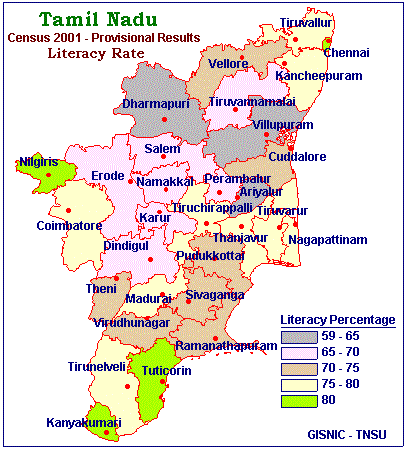Tamil Nadu’s District with the Lowest Literacy Rate
Overview of Literacy in Tamil Nadu
Tamil Nadu, a state renowned for its educational achievements, has faced disparities in literacy rates across its districts. Recent statistics highlight that while many districts show commendable literacy levels, there is a significant variance. The focus of this article is on the district with the lowest literacy rate in Tamil Nadu, which reflects ongoing challenges in the state’s educational landscape.
District with the Lowest Literacy Rate
The district with the lowest literacy rate in Tamil Nadu is Perambalur. According to the latest data, Perambalur’s literacy rate stands at a notably lower percentage compared to other districts in the state. This disparity indicates several underlying issues affecting educational access and quality in the region.
Factors Contributing to Low Literacy
Several factors contribute to Perambalur’s lower literacy rate. These include socio-economic challenges, limited access to quality educational facilities, and inadequate infrastructure. Additionally, rural areas within the district may face specific barriers such as transportation difficulties and lower enrollment rates in schools.
Initiatives to Address Literacy Issues
In response to these challenges, the Tamil Nadu government has implemented various initiatives aimed at improving literacy rates. These include enhancing school infrastructure, providing scholarships, and launching awareness programs to encourage school attendance. The government’s focus is on addressing the root causes of educational disparities and fostering a more inclusive educational environment.
Future Prospects and Goals
Looking ahead, the Tamil Nadu government aims to significantly improve literacy rates across all districts, including Perambalur. By prioritizing educational reforms and resource allocation, the state hopes to bridge the literacy gap and ensure that every district meets higher educational standards.

Why This News is Important
Understanding Regional Disparities
The news about Perambalur’s literacy rate underscores the regional disparities within Tamil Nadu’s educational system. Despite the state’s overall high literacy achievements, this data highlights that certain districts still face significant challenges. Understanding these disparities is crucial for policymakers and educators to address gaps effectively.
Focus on Targeted Interventions
By identifying the district with the lowest literacy rate, targeted interventions can be designed to address specific needs. This approach ensures that resources are allocated where they are most needed, potentially leading to more impactful educational reforms and improvements.
Socio-Economic Implications
Low literacy rates in a district often correlate with socio-economic challenges. Addressing these issues can have broader positive effects on the district’s overall development, including improved economic opportunities and better health outcomes for residents.
Policy Making and Resource Allocation
This information is vital for policymakers as it informs decisions regarding resource allocation and educational policy. Ensuring that districts with lower literacy rates receive adequate support can help achieve more equitable educational outcomes across the state.
Community and Stakeholder Engagement
The news also highlights the need for community and stakeholder engagement in addressing educational challenges. Local communities, educators, and non-governmental organizations play a critical role in supporting educational initiatives and driving positive change in districts with lower literacy rates.
Historical Context
Tamil Nadu’s Educational Landscape
Tamil Nadu has a long history of prioritizing education, with significant investments in educational infrastructure and policies aimed at improving literacy rates. The state’s commitment to education is reflected in its numerous initiatives over the years, including the establishment of schools, teacher training programs, and educational reforms.
Educational Disparities Over Time
Despite these efforts, educational disparities have persisted in certain districts. Historical factors such as economic disparities, rural-urban divides, and varying levels of government intervention have contributed to these discrepancies. Addressing these historical challenges requires a focused approach to ensure that all districts benefit equally from educational advancements.
Recent Efforts and Reforms
In recent years, the Tamil Nadu government has introduced various reforms aimed at improving literacy rates and educational quality. These include increasing school enrollments, enhancing teacher training, and investing in infrastructure. The focus remains on addressing long-standing issues and ensuring that all districts achieve higher literacy standards.
Key Takeaways from Tamil Nadu’s Literacy Rate Issue
| # | Key Takeaway |
|---|---|
| 1 | Perambalur is the district with the lowest literacy rate in Tamil Nadu. |
| 2 | Socio-economic challenges and inadequate infrastructure contribute to the low literacy rate in Perambalur. |
| 3 | The Tamil Nadu government has implemented initiatives to improve literacy rates, including infrastructure upgrades and awareness programs. |
| 4 | Addressing educational disparities requires targeted interventions and resource allocation. |
| 5 | Community and stakeholder engagement is crucial for driving educational improvements in districts with lower literacy rates. |
Important FAQs for Students from this News
1. What is the district with the lowest literacy rate in Tamil Nadu?
- The district with the lowest literacy rate in Tamil Nadu is Perambalur.
2. What factors contribute to the low literacy rate in Perambalur?
- Factors include socio-economic challenges, limited access to quality educational facilities, inadequate infrastructure, and specific barriers in rural areas such as transportation difficulties and lower school enrollment rates.
3. What initiatives has the Tamil Nadu government undertaken to improve literacy rates?
- The Tamil Nadu government has implemented several initiatives such as enhancing school infrastructure, providing scholarships, launching awareness programs, and addressing the root causes of educational disparities.
4. Why is it important to address the literacy rate disparities in Tamil Nadu?
- Addressing these disparities is crucial for ensuring equitable educational opportunities, improving socio-economic conditions, and achieving more balanced development across the state.
5. How does the literacy rate in Tamil Nadu compare to other states in India?
- Tamil Nadu generally has a high literacy rate compared to many other states in India; however, disparities still exist within the state, which highlights the need for targeted interventions.
Some Important Current Affairs Links


















